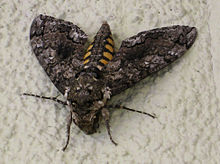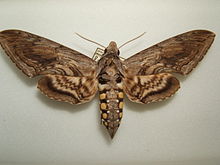- Manduca quinquemaculata
-
Tomato hornworm 
Scientific classification Kingdom: Animalia Phylum: Arthropoda Class: Insecta Order: Lepidoptera Family: Sphingidae Genus: Manduca Species: M. quinquemaculata Binomial name Manduca quinquemaculata
(Haworth, 1803)[1]Synonyms - Sphinx 5-maculatus Haworth, 1803
- Phlegethontius quinquemaculatus
- Protoparce quinquemaculatus
- Phlegethontius celeus Hübner, 1821
- Protoparce quinquemaculatus wirti Schaus, 1927
The Five-Spotted Hawkmoth (Manduca quinquemaculata) is a brown and gray hawk moth of the Sphingidae family. The caterpillar is often referred to as the tomato hornworm and can be a major pest in gardens. Tomato hornworms are closely related to (and sometimes confused with) the tobacco hornworm (Manduca sexta). This confusion arises because caterpillars of both species feed on the foliage of various plants from the family Solanaceae, so either species can be found on tobacco or tomato leaves, and the plant on which the caterpillar is found does not indicate its species. The larvae of these species can be distinguished by their lateral markings; tomato hornworms have eight V-shaped markings while tobacco hornworms have seven diagonal lines.[2] Furthermore, the caterpillars can be distinguished from the larval stage onwards by the color of the horns on their back ends: M. quinquemaculata caterpillars have black horns, while Manduca sexta caterpillars have red horns. The moths can be distinguished by the number of spots on their abdomen, with M. quinquemaculata having five.[2]
Contents
Range
M. quinquemaculata is found throughout the United States, northwestern Mexico, and even southern Canada, but is less frequently found throughout the Great Plains and the southeast.
Food plants
Tomato hornworms are known to eat various plants from the family Solanaceae, commonly attacking tomato, eggplant, pepper, tobacco, moonflowers and potato. Accordingly, tomato hornworms are often found on defoliated tomato plants, the caterpillar clinging to the underside of a branch near the trunk. They are difficult to spot due to their green coloration. Gardeners' anecdotes have mentioned the use of a blacklight to find the hornworms on tomato plants at night, where they glow under the ultraviolet. They can be reduced by planting marigold flowers around these plants.[3]
Life cycle
Egg
Hornworm eggs are spherical to oval in shape, measure about 1.5 mm (0.059 in) in diameter, and vary in color from light green to white. Eggs are deposited principally on the lower surface of foliage, but also on the upper surface. Duration of the egg stage is two to eight days, but averages five days.[2]
Larva
The tomato hornworm is a green caterpillar, with eight, v-shaped markings on its side and has a black horn on its rear just as other hornworms. It also looks like it has 7 eyes on each side.
Caterpillars can be prey to the parasitoid wasp Braconidae.
Pupa
During the summer months, moths will emerge from pupae in about 2 weeks. Moths emerge from the soil, mate, and then begin to deposit the eggs of the next generation on tomato plants. By early fall, the pupae will remain in the soil all winter and emerge as a moth the following spring.
Images
References
- ^ "CATE Creating a Taxonomic eScience - Sphingidae". Cate-sphingidae.org. http://www.cate-sphingidae.org/taxonomy/Manduca/quinquemaculatus.html. Retrieved 2011-11-01.
- ^ a b c Villanueva, Raul (June 1998). "Tobacco Hornworm". http://entomology.ifas.ufl.edu/creatures/field/hornworm.htm. Retrieved 2006-10-21.
- ^ "Marigolds". Davis Wiki. 1999-02-22. http://daviswiki.org/Marigolds. Retrieved 2011-11-01.
External links
- Tomato Hornworm Kansas State University guide
- The Tomato Hornworms Colorado State University Cooperative Extension, Denver County
- Manduca quinquemaculata, Butterflies and Moths of North America
- tomato hornworm on the UF / IFAS Featured Creatures Web site
Categories:- Manduca
- Tomato pathogens and pests
- Animals described in 1803
Wikimedia Foundation. 2010.










